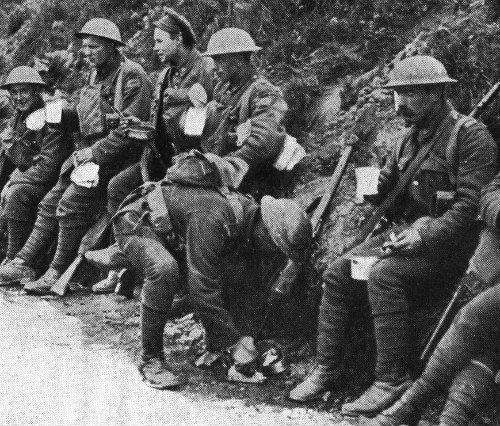Topic: Army Rations

During the First World War, school children in Canada were taught from booklets prepared by the National War Savings Committee to ensure they understood the demands being placed on the national economy to support the Overseas Military Forces of Canada (OMFC). Intended for brief periods of daily instruction, the booklets were meant to develop an understanding of the importance of War Savings and general economies. The last books were printed after the Armistice, but were equally applicable as it would still be months before the last troops returned to Canada,
The Requirements of an Army in the Field
Excerpted from The Canadian War Book, January 1919; prepared by the National War Savings Committee. Issued under the authority of the Department of Education of the Province of New Brunswick.
Perhaps many boys and girls do not realize what a great number of men half a million is. Just think: the Canadian Army Corps is equal to the whole population of Toronto; far more than all the people in Halifax and Hamilton and Winnipeg together. If all these men stood shoulder to shoulder they would make a line 140 miles long. Now, all these soldiers must be fed, clothed, supplied with guns and ammunition, and cared for when they are sick and wounded.
Remember, too, that everything our men use must be carried in ships to France or England. France can scarcely produce enough food for her own people and troops; England cannot produce nearly enough. Six French ports have been given over to the use of the British troops, three being devoted entirely to the Northern Army and three to the Southern Army. These ports are called base supply depots, and each port specializes in certain goods. One handles only forage for horses, frozen meat, and flour; another only munitions, and so on. From each port a system of broad-gauge railways runs inland, branching and re-branching to reach advanced supply depots. At these points the supplies are loaded on motor trucks or narrow-gauge railways and taken as close to the firing line as mechanical transport can go. Finally, the services of the horse and mule are called into action to furnish motive power for a divisional supply train, which consists of 455 men, 375 animals, and 198 wagons. From the divisional trains the food is taken over by brigades and then by the battalion quartermaster. He divides it into five parts, one for headquarters, and one for each of the four companies. Such supplies as fresh meats, tea, coffee, and flour are turned over to the company cooks, the individual soldier handling only “dry rations,” like bread, canned goods, jam, biscuits and pickles.
What do our soldiers get to eat? The very best and most substantial food and plenty of it. The first item is meat – fresh or frozen. Each soldier is entitled to one pound every day. In addition, he is given four ounces of bacon, usually for breakfast. Fish, too, much of it from Canada, sausages from government-owned factories, and pork and beans, are issued to supplement the meat rations. Bread is, perhaps, next in importance. Of this each soldier receives daily one pound, or ten ounces of biscuit, or an equivalent ration made up of the two. Bread for the Canadian army is made at the base bakeries at Boulogne. These turn our daily 220,000 two-pound loaves, made from Canadian flour of the same quality as in pre-war days. Other items in Private Jack Canuck's daily bill-of-fare are: ten ounces of rice, two ounces of butter served three times a week, three ounces of jam, five-eighths of an ounce of tea or coffee, two ounces of cheese, two ounces of oatmeal three times a week, three ounces of sugar, one ounce of condensed milk, an ounce of pickles three times a week, two ounces of potatoes, eight ounces of fresh vegetables when obtainable, or two ounces of dried vegetables.

